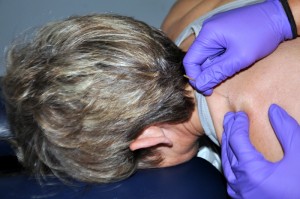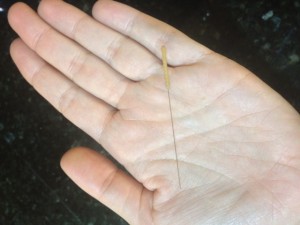Everything You Need To Know About Dry-Needling
Everything You Need to Know about Trigger Point Dry-Needling (and no, it is not acupuncture!)
One of the most cutting edge treatments to evolve over the past few years is called “Trigger Point Dry-Needling”. Much has been written about this treatment in various health magazines and journals. While this approach uses the same instrument used in accupuncture, the treatment technique and goals are very different. This blog will provide you with a comprehensive overview of this innovative treatment technique and whether it is appropriate for you.
- What is a myofascial trigger point?
A trigger point is a tight band of muscle fibers, presenting as a nodule that is painful upon compression of the tissues through palpation.
- Why did I get a trigger point?
While the cause of trigger points develop is not fully understood, it is believed that an aggravating factor causes a portion of the muscle to go into a heightened state of activity, contracting into a taut band. These perpetuating factors can be poor posture, repetitive motion, or a direct injury that places excessive stress on a muscle. In some cases, trigger points result from joint dysfunction (arthritis), nutritional deficits, or emotional stress.
- Why is it important to treat a trigger point?
Trigger points are painful in the localized area and left untreated can refer pain to other areas. Furthermore, they contribute to muscle weakness and decreased range of motion leading to impaired function.
- What is the treatment for trigger points?
Several modalities such as heat, cold, ultrasound, and electrical stimulation are commonly used to treat trigger points, but the success rate is marginal especially in chronic conditions. Manual therapy techniques such as soft tissue mobilization, manual compression techniques, and stretching have had good success, but in some instances the painful trigger points continue to persist. Trigger point dry needling (also referred to as Intramuscular Manual Therapy -IMMT), is one of the most effective treatments for musculoskeletal trigger points and is used in conjunction with these other techniques.
- What is Trigger point dry-needling and does it hurt?
Dry-needling is a treatment method designed to release trigger points using a solid filament needle (similar to those used in acupuncture). The needles used are very thin and rarely felt entering the skin. The needle is placed into the trigger point to produce a local twitch response (LTR) of the muscle. The LTR is therapeutically essential for treatment because it is usually followed by a period of reflexive relaxation of the muscle. When a person experiences a LTR, they will often feel a cramping sensation or discomfort in the referral pattern of the muscle for a few seconds.
- What should I expect afterward?
Most patients experience soreness after needling, which can last a few hours to 2 days. It is suggested that patients use moist heat or ice to decrease the soreness. Studies have also shown that when the increased tension in a trigger point is resolved, other trigger points within the pain referral zone may resolve as well.
- How many treatments will I need?
- Results are typically experienced in 3 sessions, but additional treatments may be necessary based on the chronicity of symptoms and contributing factors.
- Dry-needling is used to break the pain cycle by resolving the trigger point. When this is accomplished, other treatment techniques that focus on muscle strengthening and re-education can be introduced to the rehabilitation program.
- What should I do between treatment sessions?
- Avoid exercises that involve the muscles that were treated.
- Stretch your muscles daily through their full range as demonstrated by your physical therapist.
- Move!!! Don’t guard the area treated. The goal is to try to use the affected body part in a normal manner.
For pain that has not responded to traditional soft tissue massage and mobilization, call the experts at The Sports Rehabilitation Center.

